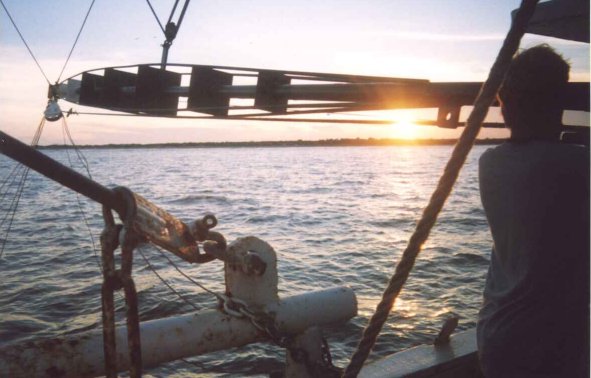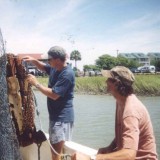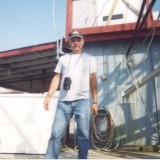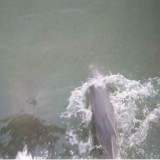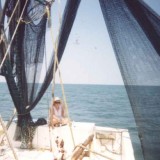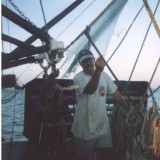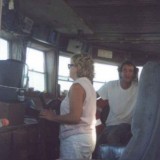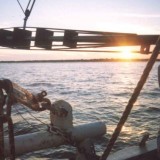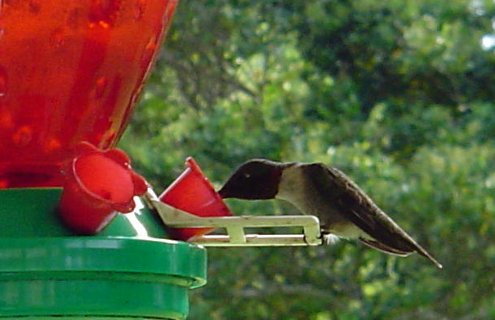Our friend, Rusty, is moving away in a few weeks. He called the other day and asked if we could get together for one last “drunk” before he goes. Sounds like a good plan!
We first met Rusty after we moved to Folly Beach. We met him at the Holiday Inn bar during happy hour one afternoon after he had just gotten back from shrimping. We had often seen his shrimp boat, the Miss Ella, docked at Crosby’s with several other commercial shrimping trawlers. My brother was already friends with Rusty, and, as a matter of fact, Dennis had turned Rusty down several times on joining him on a shrimping expedition to be his mechanic.
Well, Brian and I were hooked from the beginning and knew we would sign on to be his crew for at least one outing during shrimping season.
We ended up going out twice. The first time lasted only a day and half. We came back, not because our hull was filled with shrimp that quickly, but because we were pulling no shrimp up in the net and Captain Rusty made the decision to stop wasting fuel for nothing.
Our second trip lasted four and a half days. I consider this one of my truly ultimate experiences in life. I’ll let my journal entries tell my story:
August 26 (Trip 1)
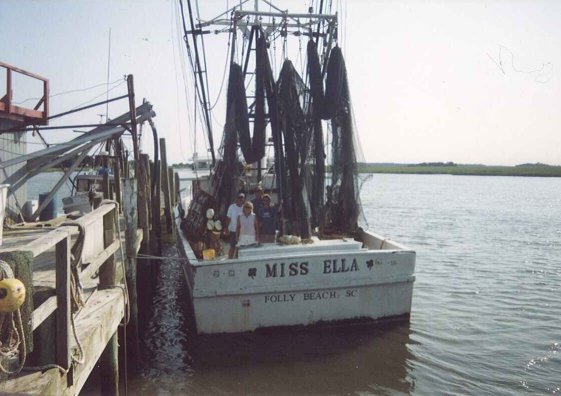
My brother took this picture from the dock.
Brian, Captain Rusty, Craig, and I finally left Crosby‘s dock today at high tide (5:25 p.m.) We ran aground once near the tip of Folly Island. One of the channel markers must be wrong! Getting out to open sea from here is very difficult. It took three hours to get through all the channel markers and get anchored off of Keowah Island for the night. I cooked chicken thighs and fried potatoes on the gas stove. I’m getting my sea legs, I think, but it’s wise to always hang on to something, though. It’s hard to read at night, the lighting is dim, everything runs off the generator. Slept very good.
August 27
It is morning and we are getting ready for our first drag. Once the outriggers are down and the net is dropped, we will drag for three hours. The goal when we pull the net up and dump its contents on the deck is to have a ton of shrimp. After the net is emptied, it is dropped in the water and the next drag is begun while the crew sorts the catch, separates the shrimp from the by-catch and pushes the by-catch back into the water. Shrimp are sorted by size, headed and put down into the hull on ice. Hopefully, the crew completes this process in three hours, so there is room on the deck to dump the next net full. And on and on it goes.
It is difficult to hold the pen steady to write this journal at times with all the bobbing and swaying going on. We dropped the net at 9:15 a.m. We are hoping to be very busy heading shrimp soon. I’m watching spinner dolphins off the stern. They are beautiful and love to play around the boat.
I drove the boat a little. Scary! Miss Ella didn’t seem to want to go where I wanted her to go. The guys were all out on deck raising the anchor. The anchor is huge with hundreds of feet of thick bull rope that can hurt you in a second. I was to keep the Miss Ella straight and try not to let her rock too much, while the guys did their dangerous work. Ten minutes of ultimate stress!
Even cooking is an adventure out here. You have to take a wide stance and sort of roll with the swells to keep your balance. The stove burners also have lips around them to help keep a hot pot from falling off. Since the Miss Ella has no refrigeration, our perishables are packed in coolers. Each day, we have to empty any melting water and refill them with ice from the hull. The cooking is a great way for me to be able to contribute more, since the guys don’t want me to be near the outriggers, anchor, or other dangerous pieces of equipment.
Rusty needed a few shackles, so I looked in the bottom of the tool box (a whopping huge wardrobe looking thing that I had to empty of tons of big dirty tools to even see the bottom). I found a few shackles at the bottom, got very dirty, but hey, good contribution on my part!
We’ll be pulling up the net soon to see our first catch.
We pulled up a lot of fish on that first drag, but only six shrimp! What? That’s not even enough to make a decent shrimp cocktail! We pulled up whiting, mackerel, flounder, star fish, sand dollars, beautiful little tropical fish, a few squid and lots of jelly balls (jelly fish). We decide to keep enough of the flounder, whiting and squid to fry up a sampler plate for our dinner.
Captain Rusty decided to find another spot to try our shrimping. We headed north towards Charleston Harbor.
After another drag, no shrimp. So, we go in search of another place to try our luck.
The shrimper captains get on their CB radios and talk to each other a lot. They don’t say much. There are long pauses in their conversations. They speculate on the shrimp, but mostly tell each other tons of lies! After all, a shrimper having great success does not want the other shrimpers infringing on his territory! Almost every conversation ends with the mantra, “It will be better next time.” In Captain Rusty’s case today, he is not lying. But, they don’t know that!
We anchored at sea for the night and had a fabulous dinner! After dinner, Rusty popped a VHS tape into the little 13 inch screen VHS player. We watched A Perfect Storm. (No kidding)
The stars are beautiful at night. I’ve never seen so many stars. Mars is closer than ever. It’s beautiful, too. I think I will sleep on this huge mass of spooled up rope on the bow.
August 28
We’re waiting for low tide to put the nets out. I’ve been reading a book. Glorious day! We had scrambled eggs for breakfast.
Since we get about eight miles to a gallon of diesel and we aren’t making any money, Captain Rusty makes the decision to cut this outing short and head back to the dock. I am very disappointed.
September 10 (Trip 2)
Full moon tonight. We haven’t left the dock yet. I filled up the coolers with ice and took a Dramamine for motion sickness. The engine is warming up. We have no water. Not because the tank isn’t filled, but because the pump might not be working.
Oh, oh. Just found out something is wrong with the steering. This could be bad. Very bad. So, it has been decided that we can’t go this evening. Good thing. If the steering went while we were trying to cross the bar between Folly and Kiawah Islands, who knows what could have happened?
To fix the steering, we need the welder and an unknown number of man hours labor. So, the guys dismantled the steering mechanism, so Captain Rusty can take it to Jimmy, the welder, in the morning.
While waiting for the next part of this adventure to get underway, we watched the Hailey Marie come back to the dock. She’s Captain Neal’s boat. As if floating across a sea of grass, she came through the channel, slowly making her way to the dock. How breathtaking! The wives of the men on that crew stood on the dock and waved at their returning wayfarers. The crew on the Hailey Marie were gone longer than usual. They had to hole-up at sea for a few days because of Tropical Storm Henri. But, she’s back now.
High and low tides are more extreme than usual because of the full moon.
Captain Rusty has taken to calling me Buttercup. I think he’s trying to make me mad as I’m sure it’s in reference to me being a girl and hating to get my hands dirty. I like him calling me that, though. Somehow being given a nickname makes me one of the crew.
I volunteered to re-plumb the sink. It is always leaking. Tomorrow may be a good day to work on it since we have no running water anyway.
Sleeping on the boat at the dock tonight.
September 11
Waiting for Captain Rusty to return from the welder. I think I’ll read in my book awhile.
At the last minute, Craig decided not to go with us. It will just be the three of us this trip. It means more work for us rookies, but also a bigger payday!
(Well, dear readers, we did have much more success on our second outing and stayed so busy, I did not write in my journal again until after we returned)
September 17 (The day after our return and my final entry)
I think we can say I’m not a whiner. I just got back from four and a half days at sea on the Miss Ella. Wow! Life on the Miss Ella is surreal, unbelievable. Her cabin and galley make me shake my head in disbelief. Honestly, if she were a woman and not a boat, she’d be a filthy whore, but you are in love with her anyway. Her stove is rusted and you can’t use the oven and if you use the wrong burner, you’ll start a fire. You may start one anyway as all her jets are choked with soot. Her cabin and galley are a patchwork of plywood and torn pieces of fiber board. Grease, soot and diesel fuel cover everything. Cockroaches and mice abound. (Yes, they do make the trip out to sea with you and crawl on you at night while you are sleeping!) The smell of diesel fuel burns your nostrils. Peeing and pooping in a bucket on choppy seas is difficult on a good day. Perishable foods begin to look a bit wilty on the third and fourth day. Your back is aching from sitting in a squat for hours on end heading shrimp. Your hands hurt from this exercise.
But, sunrises and sunsets are beautiful at sea. The quiet is astounding out there. The constant rocking of the boat is comforting. The stars are more bright, more beautiful, more plentiful. There is nothing quite like it.
We got 6 boxes of shrimp (six hundred pounds)! That was a lot of heading!
After we unloaded and changed our clothes, we went to the Holiday Inn bar for Happy Hour. The idea is to get drunk so you can get your equilibrium back! Actually, it does take several days to get over the swaying feeling going on in your head! (End of journal entries)
I think Rusty went out two or three more times that season, but we couldn’t go. We had our regular lives, regular jobs back on the mainland.
By the next shrimping season, Rusty had gotten a regular job, so he could eat and pay his bills. And he found a buyer for the Miss Ella. For him, the shrimping life was over.
He’s not alone, though. Many local shrimpers cannot make a living at it anymore. It is a dying industry. Now, most of the shrimp you see in grocery stores or order at your favorite restaurants is imported from Asia or some other place, raised on shrimp farms, using chemicals to stimulate growth and color. Big business it is. Add the cost of diesel fuel and dock fees and boat maintenance, most shrimpers cannot compete.
Rusty is a good friend. Because of him, I had what is surely one of my greatest life adventures! I’ll miss him.
P.S. By the way, if you ever see a sign at your local fishmonger or on a restaurant menu advertising “wild” shrimp, you’re buying the best!
- Brian and Captain Rusty checking equipment.
- I’m taking a break from net repair.
- Dennis sees us off.
- My brother took this picture from the dock. We would be leaving on our adventure in about an hour.
- Dolphins are curious creatures and think racing with the Miss Ella is fun!
- Nothing has to be done right now, so I am enjoying the scenery and reading a book.
- Brian at work.
- Captain Rusty doesn’t look too nervous during my driving lesson, but I was stressing!
- Sunset

